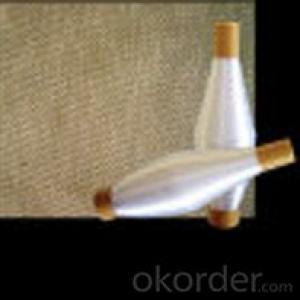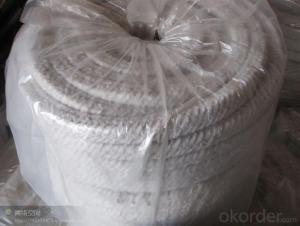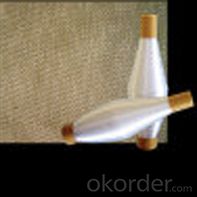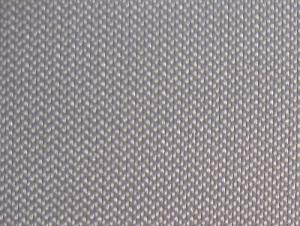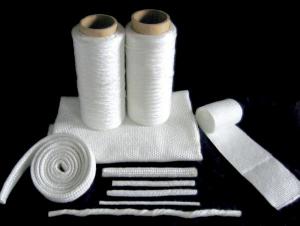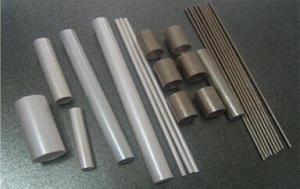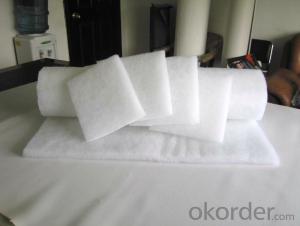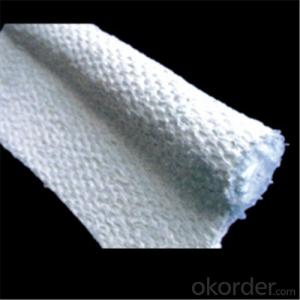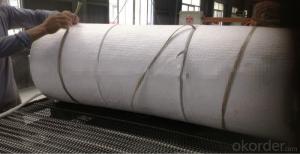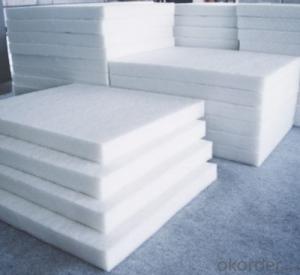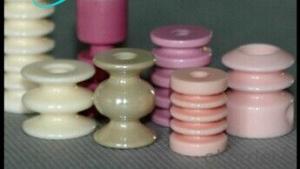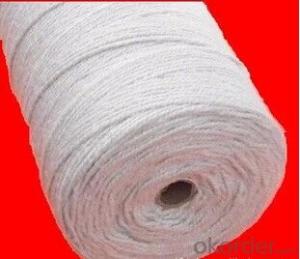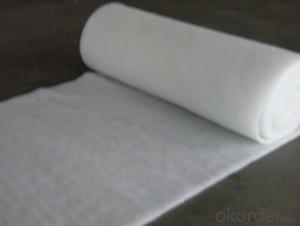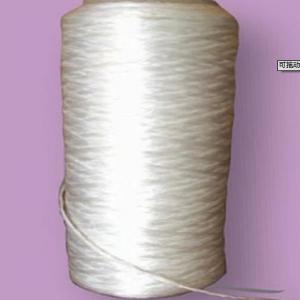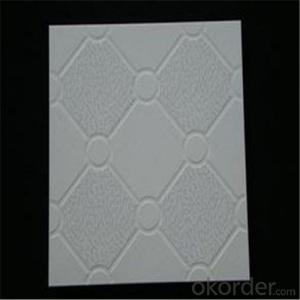Glass Fiber Textiles Heat Insulation Ceramic Fiber Textile
- Loading Port:
- Shanghai
- Payment Terms:
- TT OR LC
- Min Order Qty:
- 10 m.t.
- Supply Capability:
- 100 m.t./month
OKorder Service Pledge
OKorder Financial Service
You Might Also Like
Quick Details
| Type: | Twisted Rope | Application: | Heat Insulation | Thickness: | 4-60mm |
| Width: | 4-60mm | Length: | 30m | Grade: | HA (High Aluminum) |
| Chemical Composition: | AL2O3+SIO2 | Ultimate Strength (≥ MPa): | 0.04 | Working Temperature: | 1260 |
| Fiber Diameter: | 2-5um | Thermal Conductivity: | 0.075-0.175 w/m.k | Shrinkage (1800℉, 3h): | <=-3 |
| Place of Origin: | China (Mainland) | Brand Name: | Model Number: | HA-ceramic fiber rope | |
| Color: | White |
Packaging & Delivery
| Packaging Detail: | carton with inner plastic bag |
| Delivery Detail: | 15days after receiving advance payment |
Specifications
Heat Insulation high temperature ceramic fiber textile
professional factory
ceramic round/square/twisted rope
MSDS ISO9001
Heat Insulation Ceramic Fiber Rope
About Ceramic Fiber Rope
Iterm | Ceramic fiber rope |
Type | Ceramic fiber twisted rope |
Ceramic fiber square braided rope | |
Ceramic fiber round braided rope | |
Characteristics | ** Good thermal insulation |
** Excellent high temperature strength | |
** Good electrical insulation properties | |
** High chemical stability | |
** Low thermal conductivity | |
Typical Use | Hightemperature pipe insulation and seal, cable insulationcoating, flexible expansion joint connection,coke oven opening seal |
MOQ | 1m |
FOB Price | 4-6.5 USD/KG |
Port | Qingdao |
Payment Terms | L/C, D/A, D/P, T/T |
Packing | Carton with inner plastic bags |
Delivery | Within 15 days after delivery deposit |
Certificate | ISO9001, MSDS |
- Q: Can glass fiber textiles be used for filtration purposes?
- Yes, glass fiber textiles can be used for filtration purposes. Glass fiber textiles are known for their excellent filtration properties due to their high porosity and fine pore size. They can effectively capture and remove various contaminants such as dust, particles, and even microorganisms from fluids or gases. Glass fiber filters are commonly used in various industries, including air filtration systems, water treatment plants, and laboratory applications. Their high temperature resistance, chemical inertness, and mechanical strength make them a suitable choice for demanding filtration requirements. Overall, glass fiber textiles are a reliable and efficient option for filtration purposes.
- Q: Can glass fiber textiles be used in automotive interiors?
- Yes, glass fiber textiles can be used in automotive interiors. Glass fiber textiles, also known as fiberglass textiles, are lightweight and have excellent strength-to-weight ratio, making them suitable for a variety of applications in the automotive industry. These textiles are commonly used for reinforcing composites and providing structural support in various parts of the vehicle, including interior components. Glass fiber textiles can be used for upholstery and lining materials, offering durability and resistance to wear and tear. They are also fire-resistant, making them a safer choice for automotive interiors. Additionally, glass fiber textiles can be molded into different shapes and sizes, allowing for customization and integration into various interior designs. Moreover, glass fiber textiles offer thermal and acoustic insulation properties, helping to improve the overall comfort and noise reduction inside the vehicle. They can be used as insulation liners in the doors, roof, and floor panels, contributing to a quieter and more comfortable driving experience. In conclusion, glass fiber textiles are a versatile and suitable material for automotive interiors due to their lightweight, strength, durability, fire resistance, customization options, and insulation properties. Their use in automotive interiors helps enhance the overall quality, safety, and comfort of the vehicle.
- Q: Are glass fiber textiles suitable for sports and outdoor gear?
- Yes, glass fiber textiles are suitable for sports and outdoor gear. They are lightweight, durable, and have excellent strength-to-weight ratio, making them ideal for applications such as sports equipment and outdoor gear where performance and resilience are required. Additionally, glass fiber textiles can offer resistance to moisture, chemicals, and UV exposure, further enhancing their suitability for various outdoor activities.
- Q: Can glass fiber textiles be folded or creased?
- Yes, glass fiber textiles can be folded or creased. Glass fiber textiles are flexible and can be manipulated into various shapes and forms. However, it is important to note that excessive folding or creasing may weaken the material and reduce its overall strength and durability. Therefore, it is recommended to handle glass fiber textiles with care and avoid sharp or tight creases to maintain their integrity.
- Q: How do glass fiber textiles affect glare reduction?
- Glass fiber textiles can significantly reduce glare due to their unique properties. These textiles are made from thin strands of glass, which are woven or knit together to create a fabric. The glass fibers are highly reflective and have a smooth surface, which allows them to effectively scatter and diffuse light. When light hits the glass fiber textile, it is dispersed in multiple directions instead of being reflected directly back into the eyes of the viewer. This scattering of light reduces the intensity of glare and creates a more even distribution of light, resulting in a more comfortable and visually pleasing environment. Glass fiber textiles can be used in various applications to reduce glare, such as in window coverings, blinds, and sunshades. When these textiles are used as window coverings, they can effectively block and diffuse sunlight, preventing excessive brightness and glare from entering a room. This is particularly beneficial in spaces where glare can be a problem, such as offices, schools, or homes with large windows. Furthermore, glass fiber textiles can also be used in the manufacturing of screens and displays, such as those found in electronic devices or outdoor digital billboards. By incorporating these textiles into the screen or display, the glare caused by ambient light can be significantly reduced, enhancing visibility and improving the overall viewing experience. In summary, glass fiber textiles have a positive impact on glare reduction due to their reflective and light-scattering properties. Their ability to disperse light effectively reduces the intensity of glare and creates a more comfortable visual environment in various applications, including window coverings and screens.
- Q: Can glass fiber textile be used in acoustic panels?
- Yes, glass fiber textile can be used in acoustic panels. Glass fiber textiles, such as fiberglass cloth, have excellent sound absorption properties due to their porous structure. When used in acoustic panels, the glass fiber textile absorbs sound waves and reduces the reflection and reverberation of sound, thereby improving the acoustics of the room. Additionally, glass fiber textiles are lightweight, durable, and fire-resistant, making them suitable for use in acoustic panels. They can be easily installed and are available in various thicknesses and densities, allowing for customization to meet specific acoustic requirements. Overall, glass fiber textiles are a popular choice for acoustic panels due to their effective sound absorption capabilities and versatility.
- Q: Can glass fiber textiles be used in curtains or drapes?
- Yes, glass fiber textiles can be used in curtains or drapes. Glass fiber textiles, also known as fiberglass fabrics, are lightweight and have high tensile strength. They are commonly used in various applications such as insulation, reinforcement, and filtration. In the case of curtains or drapes, glass fiber textiles can provide several benefits. Firstly, they are fire-resistant, which makes them a safe choice for window coverings. Glass fiber textiles have a high melting point and do not catch fire easily, reducing the risk of accidents and promoting safety in homes or commercial spaces. Secondly, glass fiber textiles can provide excellent insulation properties. They can help in maintaining a comfortable indoor temperature by reducing heat transfer through windows. This can result in energy savings as it reduces the need for heating or cooling systems. Furthermore, glass fiber textiles can also offer privacy and light control. These fabrics can be manufactured with different levels of opacity, allowing for varying degrees of light transmission. They can be used to create sheer curtains that provide privacy while still allowing natural light to enter the room, or they can be used to make blackout curtains that completely block out light. Lastly, glass fiber textiles are durable and long-lasting. They are resistant to wear and tear, making them suitable for curtains or drapes that are frequently opened and closed. They are also resistant to mold and mildew, which can be beneficial in humid environments. Overall, glass fiber textiles offer a versatile and practical option for curtains or drapes. They combine safety, insulation, light control, and durability, making them a suitable choice for both residential and commercial applications.
- Q: Can glass fiber textile be used in solar panel applications?
- Yes, glass fiber textile can be used in solar panel applications. It is commonly used as a reinforcing material for the backsheet of solar panels, providing mechanical strength and durability to protect the solar cells. Additionally, glass fiber textiles can also be used in the fabrication of flexible or lightweight solar panels, offering flexibility and ease of installation.
- Q: Can glass fiber textiles be used in wall coverings?
- Yes, glass fiber textiles can be used in wall coverings. They are often used for their durability, fire resistance, and acoustical properties. Additionally, they can be woven or non-woven, allowing for a variety of textures and designs in wall coverings.
- Q: Can glass fiber textiles be used for making protective clothing?
- Glass fiber textiles have the capability to be utilized in the creation of protective clothing. These textiles are produced by weaving glass fibers together, resulting in materials that possess impressive strength and resistance to high temperatures. Consequently, they are well-suited for industries involving firefighting, welding, and chemical handling, where individuals face significant risks of exposure to heat, flames, or chemicals. In fact, glass fiber textiles are highly efficient in providing insulation and shielding against heat, fire, and select chemicals, making them an optimal selection for protective clothing. Furthermore, these textiles are lightweight, flexible, and long-lasting, facilitating ease of movement and prolonged durability even in challenging environments. It is essential, however, to bear in mind that glass fibers can cause irritation to the skin and respiratory system. Therefore, it is crucial to observe appropriate precautions and safety measures when working with glass fiber textiles and wearing the resultant protective clothing.
Send your message to us
Glass Fiber Textiles Heat Insulation Ceramic Fiber Textile
- Loading Port:
- Shanghai
- Payment Terms:
- TT OR LC
- Min Order Qty:
- 10 m.t.
- Supply Capability:
- 100 m.t./month
OKorder Service Pledge
OKorder Financial Service
Similar products
Hot products
Hot Searches
Related keywords
